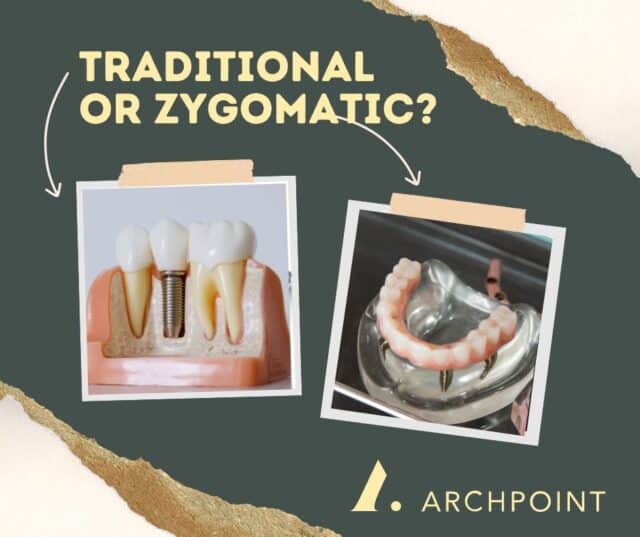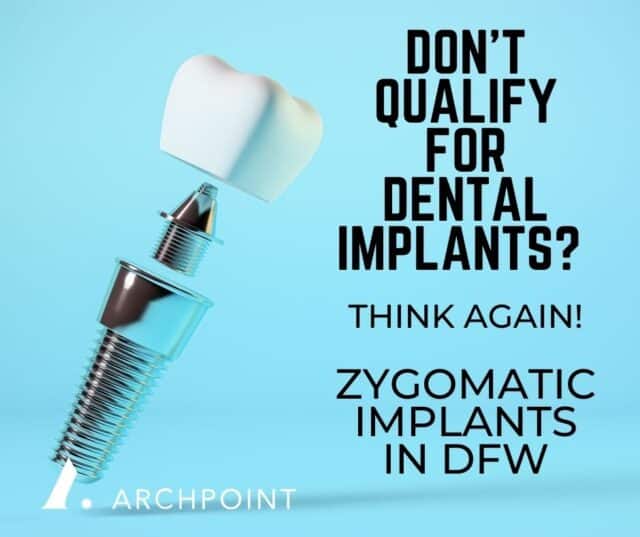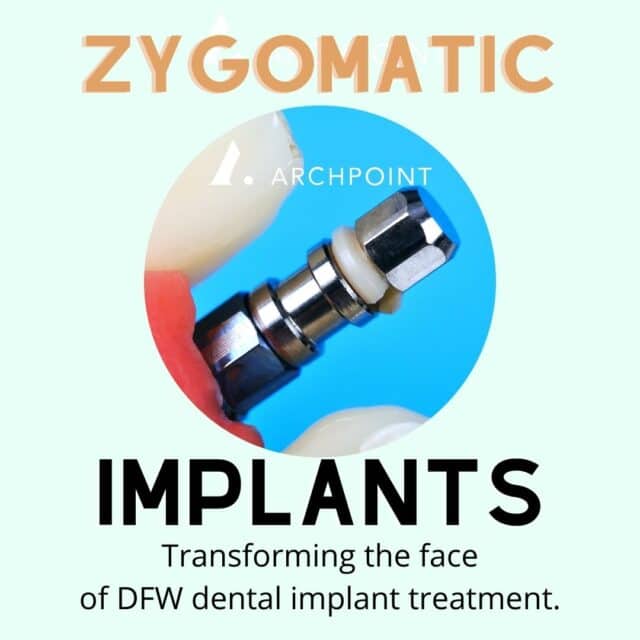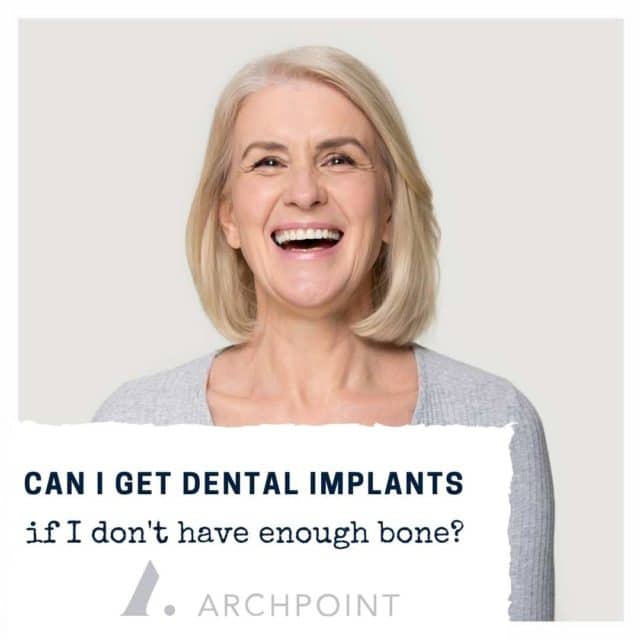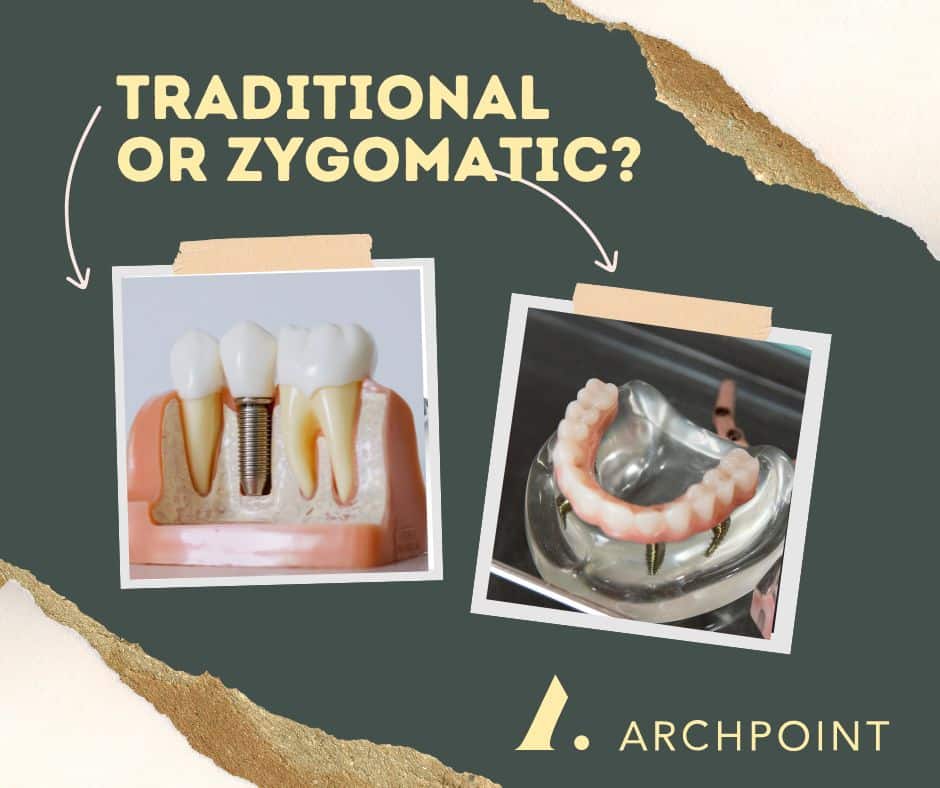
DFW dental implants are a great option for people who suffer from missing teeth. Whether teeth are lost due to poor home care, accident, illness or other factors, replacing these teeth are crucial to maintaining your overall health. Thankfully, because of advances in dental implant technology, a full arch of teeth can be replaced without the worry of having ill-fitting, uncomfortable dentures.
The certified implant dentists of ARCHPOINT utilize their expertise training and over 75 years of combined experience in the Dallas and Fort Worth area to give you the best dental implant outcome possible.
Benefits of Getting Dental Implants:
When teeth are removed, the jaw bone immediately begins to resorb (shrink.) Although the process of resorption is slow, over time this can cause dentures to not fit properly, causing painful sores and preventing you from eating many foods. The thinning of bone tissue also creates a higher risk of fracture to the jaw bone.
Surgically placed implants serve to preserve the bone tissue by acting as the roots of implant supported crowns, bridges or dentures. Dentures supported by implants will look and feel more natural and allow you to restore the full ability to eat the foods you love without the worry of your denture slipping or the need for use of adhesives.
Different Types of Implants Designs
When it comes to getting dental implants, you have options to choose from. The expert team of oral surgeons and prosthodontists of ARCHPOINT can help you find the right option to meet your unique needs and provide the most state of the art dental implant technologies to ensure the best outcome possible. The implant specialists of ARCHPOINT of Dallas and Fort Worth can give you the smile of your dreams.
Traditional Implants in Dallas and Fort Worth
Traditional implants are the most commonly used implant design to replace missing teeth. They’ve been in use since the late 1960’s. The implant specialists of ARCHPOINT are experts at placing traditional implants to give you the smile you always wanted. This type of implant can be used to replace a single tooth, multiple teeth or an entire arch of teeth.
A traditional implant is a screw like post made of the highest quality titanium that is surgically placed into the bone structure and allowed to heal for about 3 months. Once the implant is fully integrated into the bone, a custom made crown is then placed onto the implant, resulting in a natural looking and feeling replacement tooth that is able to withstand heavy bite forces.
With the use of implant retained dentures or the innovative All-on-4 system, an entire arch of teeth can be replaced with the use of as few as four implants.
As with any surgical dental procedure, not all individuals are candidates for traditional implants. A substantial amount of bone tissue is required to support a traditional implant. Oftentimes, when teeth have been missing a long time and bone resorption has occurred, bone-grafting is necessary. This is an additional procedure that will increase not only the cost of replacing the teeth but also the total amount of time to complete treatment. Bone grafts can take up to 3-6 months to fully heal prior to implant placement.
A sinus lift is also a common procedure necessary before the placement of implants. The sinus cavity is located just above the maxillary bone of the upper jaw. When the maxillary bone resorbs, the sinus cavity often widens into that space. If an implant is placed without the proper amount of bone tissue, the sinus can be intruded upon which can complications including sinusitis and failure of the implant.
Thankfully, there’s a solution for people who don’t qualify for traditional implants because of bone loss.
Zygomatic Implants at ARCHPOINT
Because of the amount of bone tissue and bone mass needed to successfully place traditional implants, some patients are just not good candidates for that treatment. In the past, these patients either went without implants or suffered with ill-fitting dentures.
Zygomatic implants were developed in the late 1990’s and provide an alternative for patients that are not candidates for traditional implants. The implant specialists of ARCHPOINT have undergone specialized training and are able to provide replacement teeth to more people than ever before, thanks to these unique implant designs.
The term zygomatic refers to the zygoma bone, also known as your cheekbone. Zygomatic implants are anchored into the cheekbone rather than the jaw bone. Because the cheekbone is utilized, these implants are only available for replacing teeth in the upper jaw (maxilla.) The zygoma bone structure is much denser and does not resorb due to missing teeth, making it a perfect to solution to thinning jaw bone.
Zygomatic implants are significantly longer and are often placed at more of an angle than traditional implants making them very strong. These implants can be utilized to support a single tooth replacement crown, multiple tooth bridges or an entire arch of teeth. Zygomatic implants can also be used in combination with traditional implants depending on a patients unique needs.
Because zygomatic implants are placed into the cheekbone, the need for additional procedures like bone grafts or sinus lifts can often be eliminated. Without the need for these additional procedures, patients can receive their implants and replace missing teeth much sooner and treatment costs are often more conservative.
Caring for Traditional or Zygomatic Implants
Both traditional and zygomatic implants have high success rates close to 98% and can last decades. It is the responsibility of each patient however, to follow their doctor’s recommendation to properly care for their implants to ensure they last a lifetime. Good home care such as daily brushing and flossing are necessary. Smoking can interfere with the fusion of the implant into the bone and should always be avoided. Frequent preventative appointments for professional cleanings and exams will ensure that your implants, bone and gum tissue stay healthy and last a lifetime.
What are You Waiting For?
The dedicated team of oral surgeons, prosthodontists and sedation dentists at ARCHPOINT work together to ensure the best dental implant outcome possible for you. Each portion of your procedure can be completed in our conveniently located Dallas and Fort Worth office, which eliminates the need for referrals and longer wait times. What are you waiting for? If you have missing teeth, contact our DFW implant dentists for a consultation. ARCHPOINT will help you determine which type of implant solution is perfect for you!
